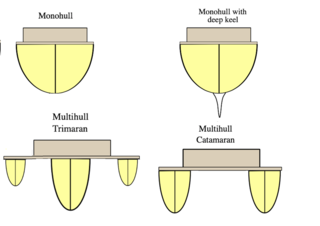
A multihull is a boat or ship with more than one hull, whereas a vessel with a single hull is a monohull. The most common multihulls are catamarans, and trimarans. There are other types, with four or more hulls, but such examples are very rare and tend to be specialised for particular functions.

A ship is a large vessel that travels the world's oceans and other navigable waterways, carrying cargo or passengers, or in support of specialized missions, such as defense, research and fishing. Ships are generally distinguished from boats, based on size, shape, load capacity and purpose. Ships have supported exploration, trade, warfare, migration, colonization, and science. Ship transport is responsible for the largest portion of world commerce.
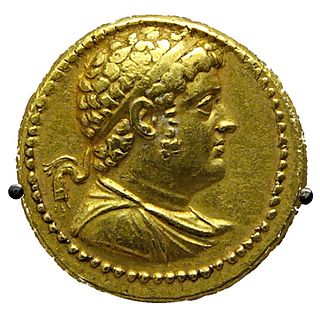
Ptolemy IV Philopator was the fourth pharaoh of Ptolemaic Egypt from 221 to 204 BC.

Seamanship is the art, competence, and knowledge of operating a ship, boat or other craft on water. The Oxford Dictionary states that seamanship is "The skill, techniques, or practice of handling a ship or boat at sea."

A dry dock is a narrow basin or vessel that can be flooded to allow a load to be floated in, then drained to allow that load to come to rest on a dry platform. Dry docks are used for the construction, maintenance, and repair of ships, boats, and other watercraft.

A rudder is a primary control surface used to steer a ship, boat, submarine, hovercraft, airship, or other vehicle that moves through a fluid medium. On an airplane, the rudder is used primarily to counter adverse yaw and p-factor and is not the primary control used to turn the airplane. A rudder operates by redirecting the fluid past the hull or fuselage, thus imparting a turning or yawing motion to the craft. In basic form, a rudder is a flat plane or sheet of material attached with hinges to the craft's stern, tail, or afterend. Often rudders are shaped to minimize hydrodynamic or aerodynamic drag. On simple watercraft, a tiller—essentially, a stick or pole acting as a lever arm—may be attached to the top of the rudder to allow it to be turned by a helmsman. In larger vessels, cables, pushrods, or hydraulics may link rudders to steering wheels. In typical aircraft, the rudder is operated by pedals via mechanical linkages or hydraulics.

A warship or combatant ship is a ship that is used for naval warfare. Usually they belong to the navy branch of the armed forces of a nation, though they have also been operated by individuals, cooperatives and corporations. As well as being armed, warships are designed to withstand damage and are typically faster and more maneuverable than merchant ships. Unlike a merchant ship, which carries cargo, a warship typically carries only weapons, ammunition and supplies for its crew.
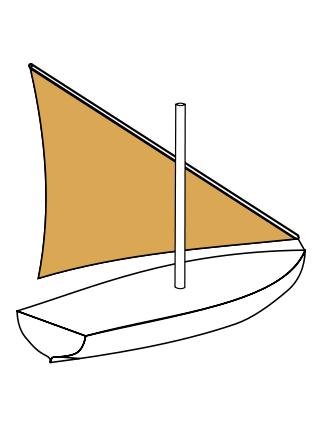
A lateen or latin-rig is a triangular sail set on a long yard mounted at an angle on the mast, and running in a fore-and-aft direction. The settee can be considered to be an associated type of the same overall category of sail.

From the 4th century BC on, new types of oared warships appeared in the Mediterranean Sea, superseding the trireme and transforming naval warfare. Ships became increasingly large and heavy, including some of the largest wooden ships hitherto constructed. These developments were spearheaded in the Hellenistic Near East, but also to a large extent shared by the naval powers of the Western Mediterranean, specifically Carthage and the Roman Republic. While the wealthy successor kingdoms in the East built huge warships ("polyremes"), Carthage and Rome, in the intense naval antagonism during the Punic Wars, relied mostly on medium-sized vessels. At the same time, smaller naval powers employed an array of small and fast craft, which were also used by the ubiquitous pirates. Following the establishment of complete Roman hegemony in the Mediterranean after the Battle of Actium, the nascent Roman Empire faced no major naval threats. In the 1st century AD, the larger warships were retained only as flagships and were gradually supplanted by the light liburnians until, by Late Antiquity, the knowledge of their construction had been lost.

The mast of a sailing vessel is a tall spar, or arrangement of spars, erected more or less vertically on the centre-line of a ship or boat. Its purposes include carrying sails, spars, and derricks, giving necessary height to a navigation light, look-out position, signal yard, control position, radio aerial or signal lamp. Large ships have several masts, with the size and configuration depending on the style of ship. Nearly all sailing masts are guyed.

A foresail is one of a few different types of sail set on the foremost mast (foremast) of a sailing vessel:

Tessarakonteres, or simply "forty", was a very large catamaran galley reportedly built in the Hellenistic period by Ptolemy IV Philopator of Egypt. It was described by a number of ancient sources, including a lost work by Callixenus of Rhodes and surviving texts by Athenaeus and Plutarch. According to these descriptions, supported by modern research by Lionel Casson, the enormous size of the vessel made it impractical and it was built only as a prestige vessel, rather than an effective warship. The name "forty" refers not to the number of oars, but to the number of rowers on each column of oars that propelled it, and at the size described it would have been the largest ship constructed in antiquity, and probably the largest human-powered vessel ever built.

The Nemi ships were two ships, of different sizes, built under the reign of the Roman emperor Caligula in the 1st century AD on Lake Nemi. Although the purpose of the ships is speculated upon, the larger ship was an elaborate floating palace, which contained quantities of marble, mosaic floors, heating and plumbing, and amenities such as baths. Both ships featured technology thought to have been developed historically later. It has been stated that the emperor was influenced by the lavish lifestyles of the Hellenistic rulers of Syracuse and Ptolemaic Egypt. Recovered from the lake bed in 1929, the ships were destroyed by fire in 1944 during World War II.

The Ptolemaic Kingdom or Ptolemaic Empire was an Ancient Greek polity based in Egypt during the Hellenistic period. It was founded in 305 BC by the Macedonian general Ptolemy I Soter, a companion of Alexander the Great, and ruled by the Ptolemaic dynasty until the death of Cleopatra VII in 30 BC. Reigning for nearly three centuries, the Ptolemies were the longest and final dynasty of ancient Egypt, heralding a distinctly new era for religious and cultural syncretism between Greek and Egyptian culture.
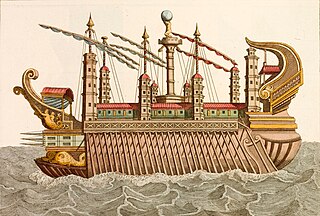
Syracusia was an ancient Greek ship sometimes claimed to be the largest transport ship of antiquity. She was reportedly too big for any port in Sicily, and thus only sailed once from Syracuse in Sicily to Alexandria in the Ptolemaic Kingdom of Egypt, whereupon she was given as a present to Ptolemy III Euergetes. The exact dimension of Syracusia is unknown; Michael Lahanas put it at 55 m long, 14 m wide, and 13 m high.

In traditional nautical use, well decks were decks lower than decks fore and aft, usually at the main deck level, so that breaks appear in the main deck profile, as opposed to a flush deck profile. The term goes back to the days of sail. Late-20th-century commercial and military amphibious ships have applied the term to an entirely different type of hangar-like structure, evolving from exaggerated deep "well decks" of World War II amphibious vessels, that can be flooded for lighters or landing craft.
Ships were used during the Eighteenth Dynasty of ancient Egypt to transport obelisks from the quarry to their destination. Fifteen centuries later, the Romans used ships to transport obelisks across the Mediterranean to Rome. Today, eight ancient Egyptian obelisks stand in Rome, though not in their original places. The first of the obelisks, the 263-ton Flaminian obelisk, was transported from Heliopolis – modern-day Cairo – in 10 BCE. while the last, the 500-ton Lateran obelisk, was transported from Karnak.

The bipod mast is a two-legged mast used originally in Egypt during the 3rd millennium BCE. It can be described as two poles secured together at the top, forming a thin isosceles triangle. It did not appear until the Old Kingdom, third dynasty, and disappeared after the sixth dynasty when the pole mast took over during the Middle Kingdom.
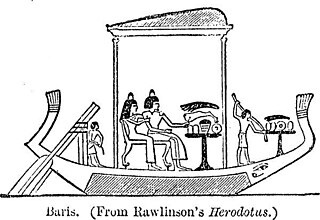
A baris is a type of Ancient Egyptian ship, whose unique method of construction was described by Herodotus, writing in about 450 BC. Archeologists and historians could find no corroboration of his description until the discovery of the remains of such a ship in the waters around Thonis-Heracleion in Aboukir Bay in 2003.


















